This is a transcript of The Data of Long-Lived Institutions, a talk by Alexander Rose at the "Long Lived Institutions" special event at The Interval. It has been edited for length and clarity.
I want to lead you through some of the research that I’ve been doing on a meta-level around long-lived institutions, as well as some observations of the ways various systems have lasted for hundreds of thousands of years.
Long Now as a Long-lived Institution
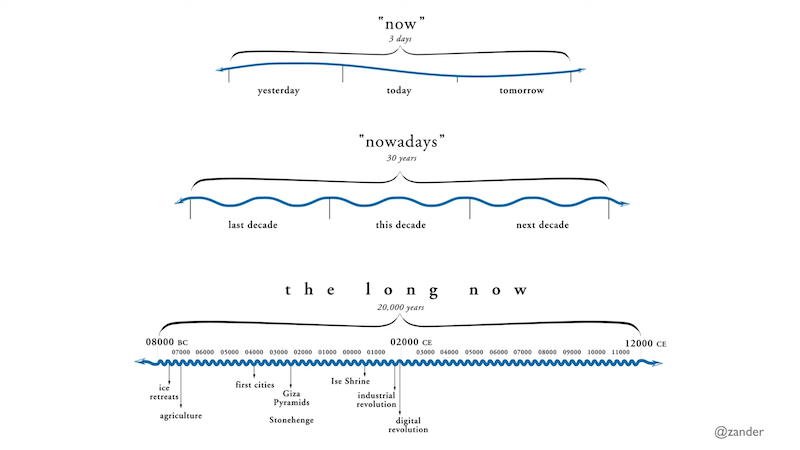
This is one of the early projects I worked with Stewart Brand on at Long Now. We were trying to define our problem space and explore the ways we think on different timescales. Generally, companies are working in the “nowadays,” although that’s been shortening to some extent, with more quarterly thinking than decade-level thinking.
It was Peter Schwartz who suggested this 10,000 year timeframe. Danny Hillis’ original idea for what would ultimately become The 10,000 Year Clock was that it would be a Millennium Clock: it would tick once a year, bong once a century, and the cuckoo would come out once a millennium. He didn’t really have an end date.
We use the 10,000 year time frame to orient our efforts at Long Now because global civilization arose when the last Interglacial period ended 10,000 years ago. It was only then, around 8,000 BC, that we had the emergence of agriculture and the first cities. If we can look back that far, we should be able to look forward that far. Thinking about ourselves as in the middle of a 20,000 year story is very different than thinking about ourselves as at the end of a 10,000 year story.
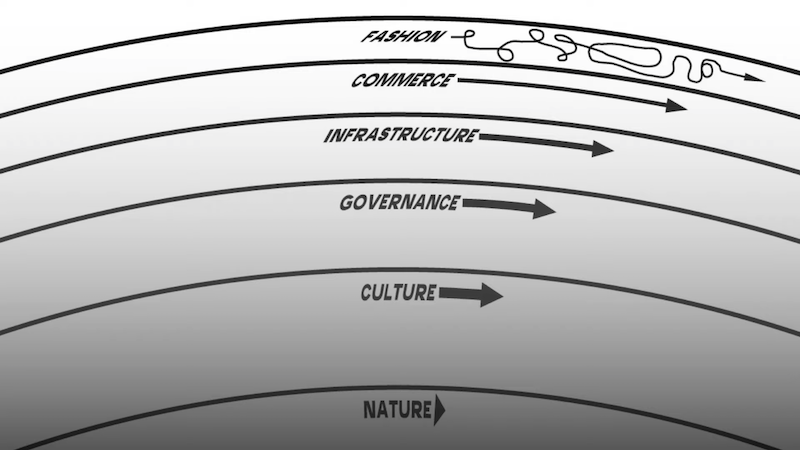
This pace layers diagram is the very first thing I worked on at Long Now. The notion of pace layers came out of a discussion between Stewart and Long Now co-founder Brian Eno. They were trying to tease apart these layers of human time.
Institutions can be mapped across the pace layers diagram as well. Take Apple Computer, for example. They’re coming out with new iPhones every six months, which is the fashion layer. The commerce layer is Apple selling these devices. The infrastructure layer is the cell phone networks and chip fabs that it’s all built on. The governance layer — and note that it is governance, not government; they’re mostly working with governments, but they also have to work with general governing systems. Some of these companies are hitting walls against different types of governments who have different ideas of privacy, different ideas of commercialization, and they’re now having to shape their companies around that. And then obviously, culture is moving slower underneath all of this, but Apple is starting to affect culture. And then there’s the last pace layer, nature, moving the slowest. At some point, Apple is going to have to come to terms with the level of environmental damage and problems that are happening on the nature pace layer if it is going to be a company that lasts for hundreds or a thousand years. So we could imagine any large institution mapped across this and I think it’s a useful tool for that.
Also very early on in Long Now’s history, in 01997, Kees van der Heijden, who wrote the book on scenario planning, came to a charrette that Long Now organized to come up with business ideas for our organization. He formulated a business plan that was strangely prophetic:
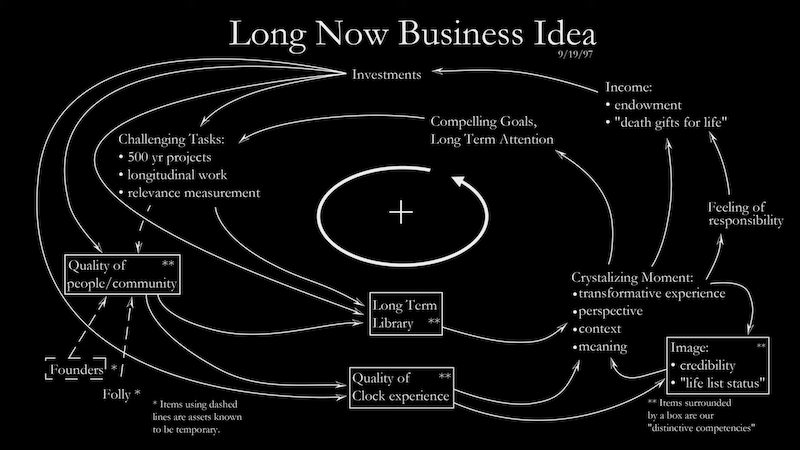
The squares are areas where we have core competencies. The dotted lines indicate temporary competencies, like the founders. The other items indicate all the things we hadn’t really gotten to yet or figured out: we didn’t have a way of funding ourselves; we didn’t have a membership program; we didn’t have a large community of donors; we didn’t have an endowment; and we didn’t have people willing to give their estates to us. We still don’t have an endowment or people willing to give us their estates, but we’ve achieved the rest. And now that we’ve been around for 22 years, we can imagine how those two items are going to start to happen next.
I also want to point out the cyclical nature of this diagram. There’s no system in the world that I’ve found that is linear that has lasted on these timescales. You need to have a cyclical business model, not a linear business model.
The Longest-Lived Institutions in the World
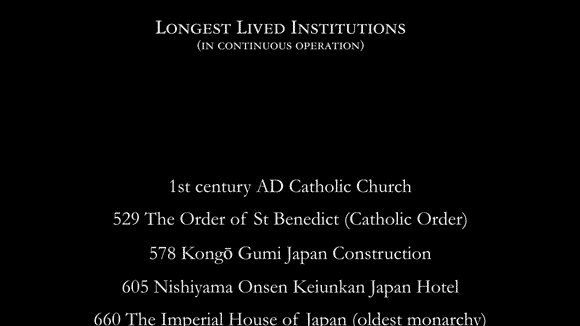
I’ve been collecting data on all of the longest-lived institutions in the world. As you look at these, there’s a few things that stick out. Notice: brewery, brewery, winery, hotel, bar, pub, right? And also notice that a lot of them are in Japan. There’s been a rough system of government there for over 2,000 years (the Royal Family) that’s held together enough to enable something like the Royal Confectioner of Japan to be one of the oldest companies in the world. But there’s also temple builders and things like that.
In the West, most of the companies that have survived for a very long time are basically service companies. It’s a lot easier to reinvent yourself as a service-oriented company than it is as a commodity company when that particular commodity goes out of use.
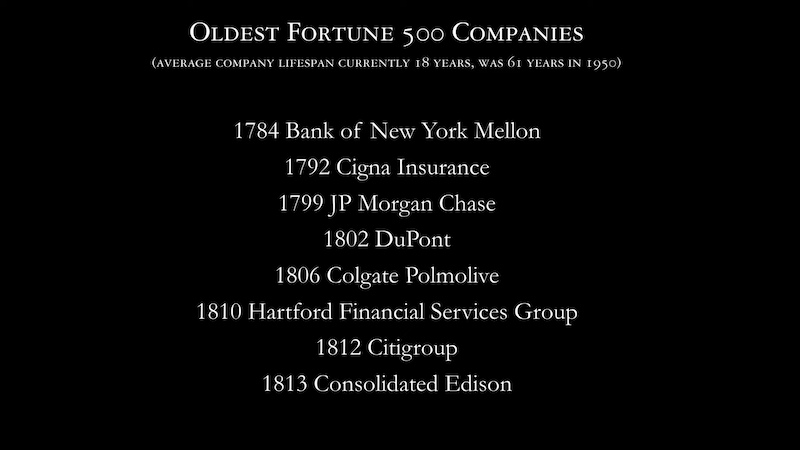
Colgate Palmolive (founded 01806) and DuPont (founded 01802) are commodity companies that are broad enough to change the kinds of products they sell over time. I’m interested in learning more about all these companies, as they probably all have some kind of special sauce in their stories of longevity.
Something else that came out of this research is the fact that the length of company’s lives is shrinking at almost one year per year. In 01950, the average company on the Fortune 500 had been around for 61 years. Now it’s 18 years. Companies’ lives are getting shorter.
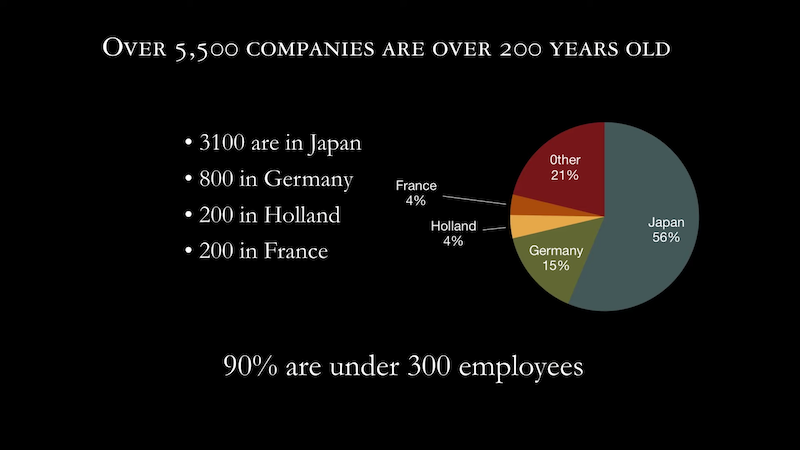
As I mentioned, most of the oldest companies in the world are in Japan. In a survey of 5,500 companies over 200 years old, 3,100 are based in Japan. The rest are in some of the older countries in Europe.
But — and this was a fact I found curious, and one that speaks to the cyclical nature of things — 90% of the companies that are over 200 years old have 300 employees or less; they’re not mega companies.
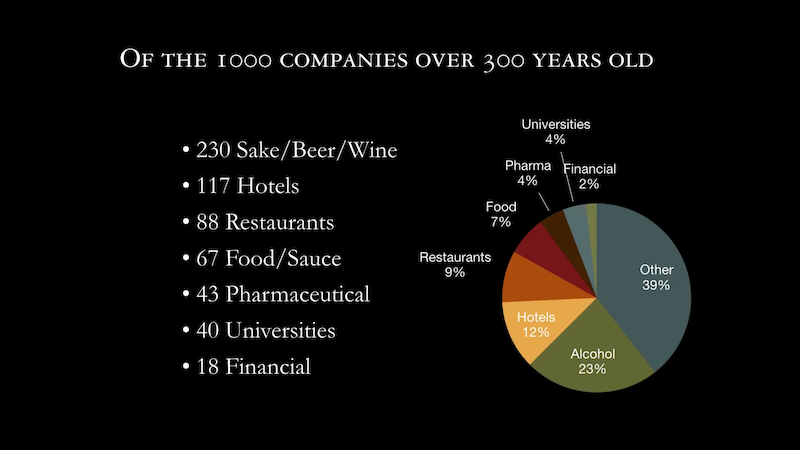
In surveying 1,000 companies over 300 years old, you find a huge amount of disparity concerning which industries they’re a part of. But there were a few big groupings that I found interesting. 23% are in the alcohol industry, and this doesn’t even include pubs and restaurants and hotels that may sell alcohol.
Patrick McGovern, a biomolecular archeologist who I talked to when we were building The Interval, has done DNA analysis on vines, which are a clonal species. From that analysis, we know that civilization started cultivating wine around 8,000 BC. McGovern supposes that it’s not at all clear if civilization stopped being nomadic in order to ferment things, or because they started fermenting things, they stopped being nomadic. It’s an intriguing correlation, and notable that some of this overwhelmingly large segment of the oldest companies in the world deal in alcohol.
Long-term Thinking is Not Inherently Good

A quick word about values: long-term thinking, and aspiring to be a long-term institution, is not inherently good. At Long Now, we’ve always emphasized the importance of long-term thinking without trying to ascribe a lot of values to it. But I don’t think that’s intellectually honest. We have to ask ourselves what we’re trying to perpetuate. We have to step back far enough and ensure that the kinds of things we’re perpetuating are generally good for society.
How to Build Things That Last

One way that things have lasted for a really long time is to just take a really long time to build them. Cathedrals are a famous example of this. The most dangerous time for anything that’s lasting is really just one generation after it was built. It’s no longer a new, cool thing; it’s the thing that your parents did, and it’s not cool anymore. And it’s not until another couple generations later where everyone values it, largely because it is old and venerable and has become a kind of cultural icon.
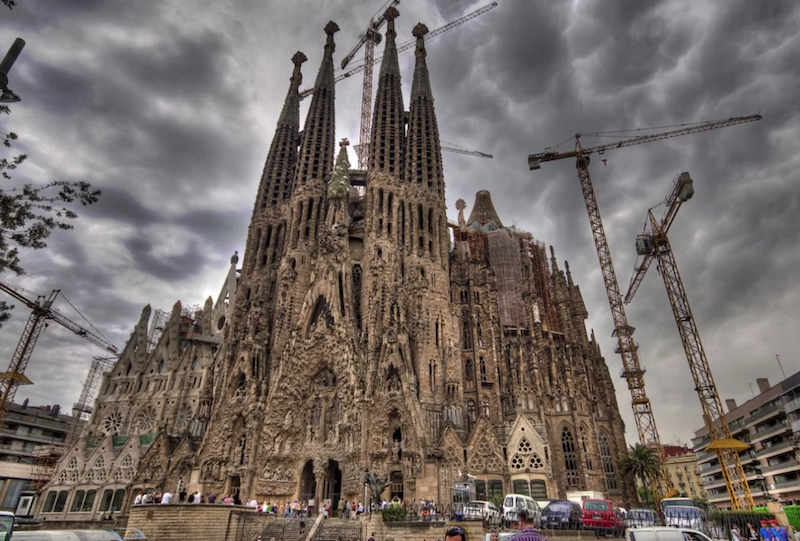
And we already see this with this cathedral: the Sagrada Familia in Barcelona. It’s still under construction, 125 years into its build process, and it’s already a UNESCO World Heritage Site.
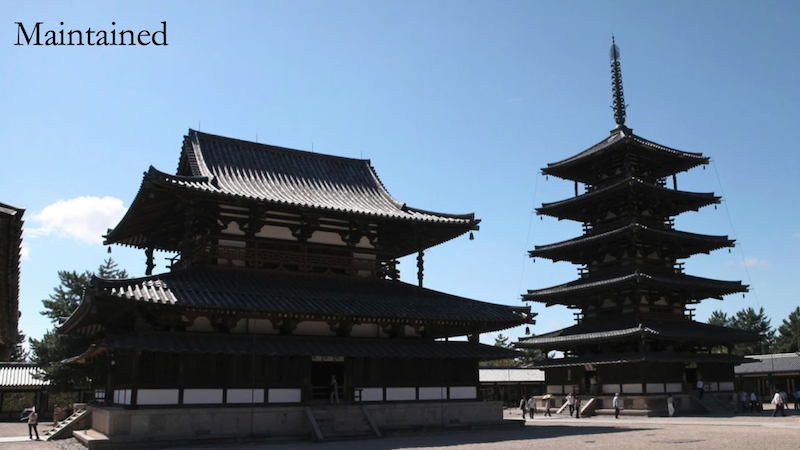
The other way things last for a really long time, and this is the Japanese model, is that they’re just extremely well-maintained.
At about 1,400 years old, these are the two oldest continuously standing wooden structures in the world. And they’ve replaced a lot of parts of them. They keep the roofs on them, and even in a totally humid and raining environment, the central timbers of these buildings have stayed true. Interestingly, this temple was also the place where, over a thousand years ago, a Japanese princess had a vision that she needed to send a particular prayer out to the world to make sure that it survived into the future. And so she had, literally, a million wooden pagodas made with the prayer put inside them, and distributed these little pagodas as far and wide as she could. You can still buy these on eBay right now. It’s an early example of the philosophy of “Lots of Copies Keep Stuff Safe” (LOCKSS).
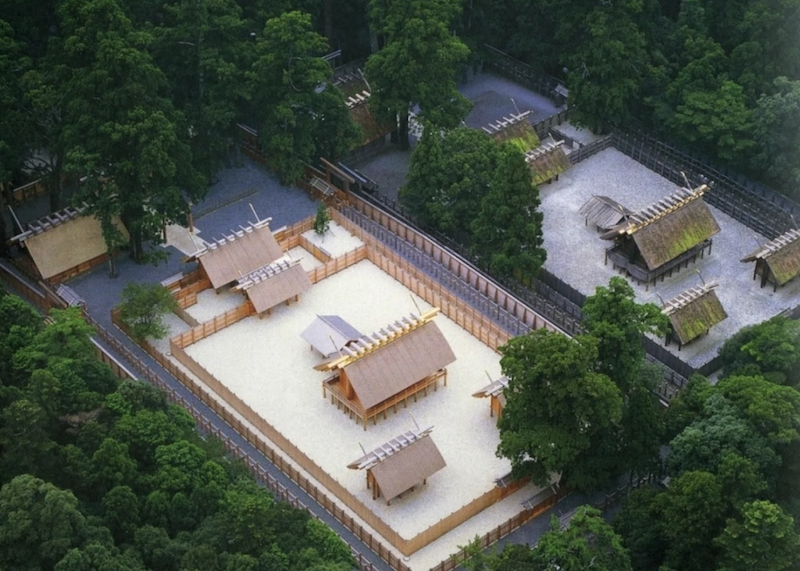
Another Japanese example that uses a totally different strategy is this Shinto shrine.
Shinto is an animist religion whose adherents believe that spirits are in everything, unlike Buddhism, which came to Japan later. In the Shinto belief system, temples have this renewing technology, if you will, where they’re rebuilt in a site right next to each other in different periodicities. This one, which is the most famous in Japan, is the Ise Shrine, which is rebuilt every 20 years. A few years ago, I was fortunate enough to attend the rebuilding ceremony. (One of the oldest companies in the world, I should add, is the Japanese temple building company that builds these temples.)
The emphasis here is not on maintenance, but renewal. These temples made of thatch and wood — totally ephemeral materials — have lasted for 2,000 years. They have documented evidence of exact rebuilding for 1,600 years, but this site was founded in 4 AD — also by a visionary Japanese princess. And every 20 years, with the Japanese princess in attendance, they move the treasures from one from one temple to the other. And the kami — the spirits — follow that. And then they deconstruct the temple, the old one, and they send all those parts out to various Shinto temples in Japan as religious artifacts.
I think the most important thing about this particular example is that each generation gets to have this moment where the older master teaches the apprentice the craft. So you get this handing off of knowledge that’s extremely physical and real and has a deliverable. It’s got to ship, right? “The princess is coming to move the stuff; we have to do this.” It’s an eight year process with tons of ritual that goes into rebuilding these temples.
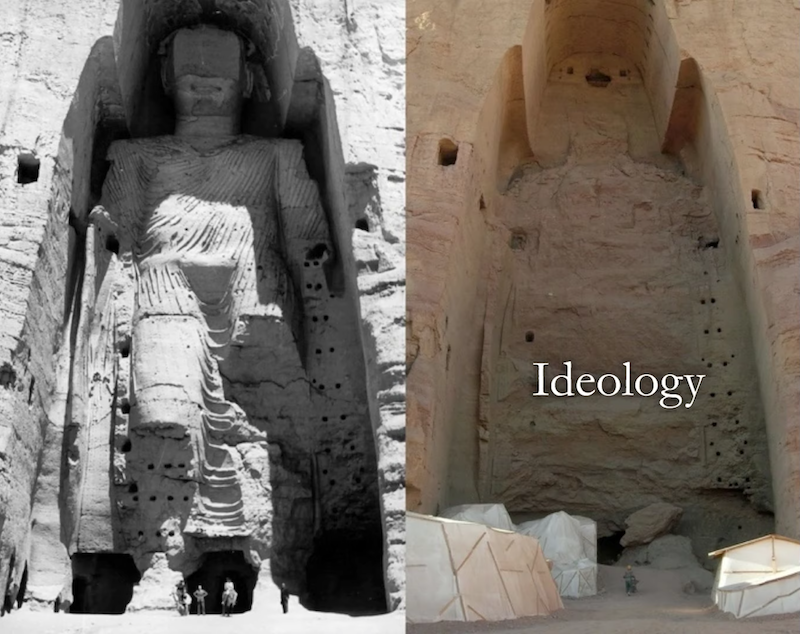
I think an interesting counterexample to things lasting a very long time is when they ascribe to certain ideologies. And I think it’s curious that one of our longest-lived institutions is the Catholic Church, and the ideology of something like the Buddha’s Obamian has lasted, but a lot of the artifacts become targets for people who don’t believe in that ideology. The Taliban spent weeks dynamiting and using artillery to destroy these Buddhas. You would think that Buddhism, a relatively innocuous religion, is unthreatening — but not so much to the Taliban.
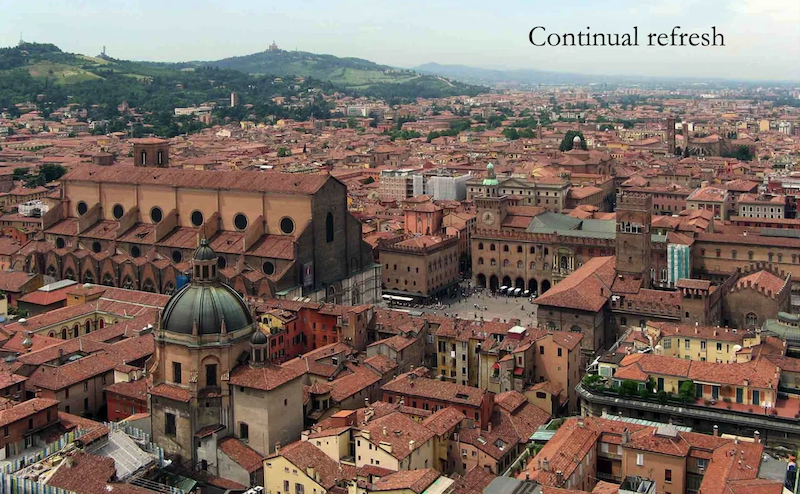
This is the University of Bologna, which is largely credited as the earliest university in the world. It’s almost 1000 years old at this point. Oxford was shortly behind it. And there’s another 40 or so universities over 500 years old.
Universities have this ability to do a kind of continual refresh where every four years, especially in undergraduate programs, you have a whole new set of people. And so they have to sell themselves to a new generation every single year. Their customer is a whole class. And we see universities now struggle when they aren’t teaching relevant things to people and they have to adjust. And that has kept them around as some of the longest-lived institutions in the world.
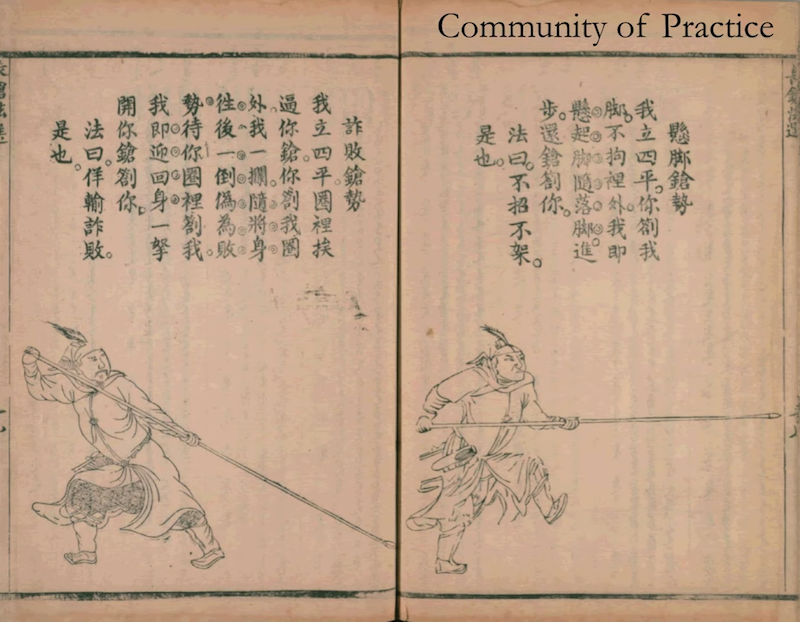
I think the idea of communities of practice is a really interesting one. In these communities, knowledge of practice is handed down from generation to generation. Such is the case with martial arts, which we have evidence for dating back at least 2,000 or 3,000 years.

There’s several strategies in nature that allow systems to last for thousands of years. There’s clonal strategies like the Aspen tree. We’ve measured Mesquite rings in the desert where they die and then they grow up in a ring from the root structure, indicating that a Mesquite ring has the same DNA, effectively, for 50,000 years. And these clonal forests have definitely been around for thousands of years, even though each individual will only last a few years in some cases.
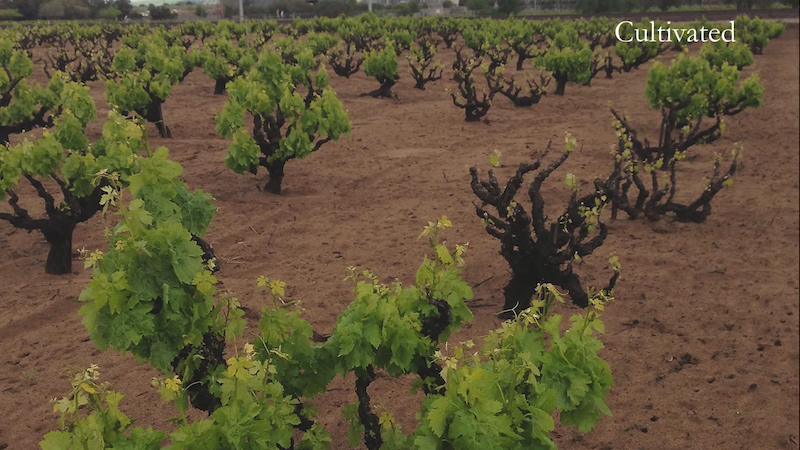
In other cases, things are cultivated. Going back to the wine example, where we know we have the DNA of clonal species like these grapes from ancient Rome where we have taken a clipping and cultivated it from generation to generation. So there’s been this kind of interplay between humans and the natural world and we also see this in a lot of tree-caring practices.
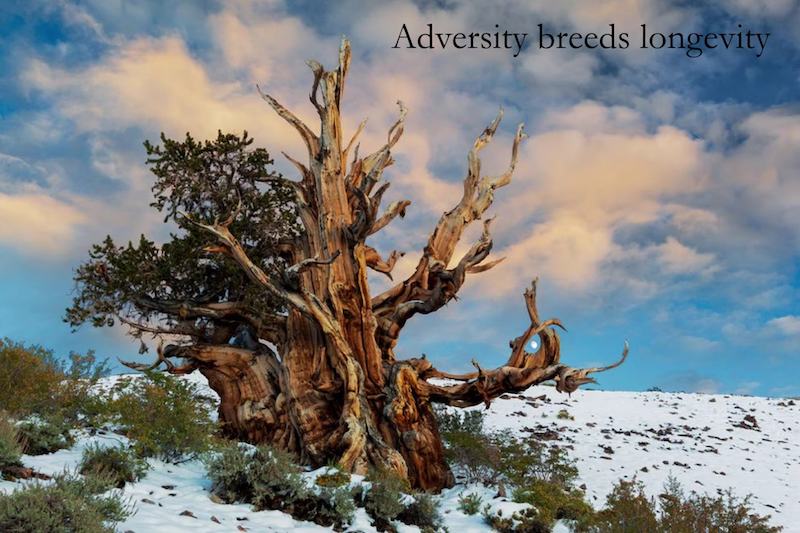
The bristlecone exemplifies how an existential crisis gives you practice in terms of how you’re going to survive. The bristlecone is the oldest continuously living single organism that we know of in the world. And the funny thing about the bristlecone is it was not discovered to be the oldest living species in the world by coring; it was postulated because a particular tree scientist had cored other pine species, and as they did that, they found that all the ones in the worst environments were the oldest. And he said: “If you can find the pine species that is living in the absolute worst environment, you will find the oldest species of pine in the world.” And he coined this term: adversity breeds longevity. And so then people went to go find the pines in the worst environment and up at the top of the White Mountains and in the Snake Range in Nevada, and some in Colorado as well, and they found three different species of bristlecone, which have been dated to over 5,000 years at this point.
Taking the Future into Account

If any of us are to build an institution that’s going to last for the next few hundred or 1,000 years, the changes in demographics and the climate are a big part of it. This is the projected impact of climate change on agricultural yields until the 02080s. And as you can see, agricultural yields in the global south are going to be going down. In the global north and the much further north, more like Canada and Russia, they’re going to be getting a lot better. And this is going to change the world markets, world populations, and what we’re warring over for the next 100 years.
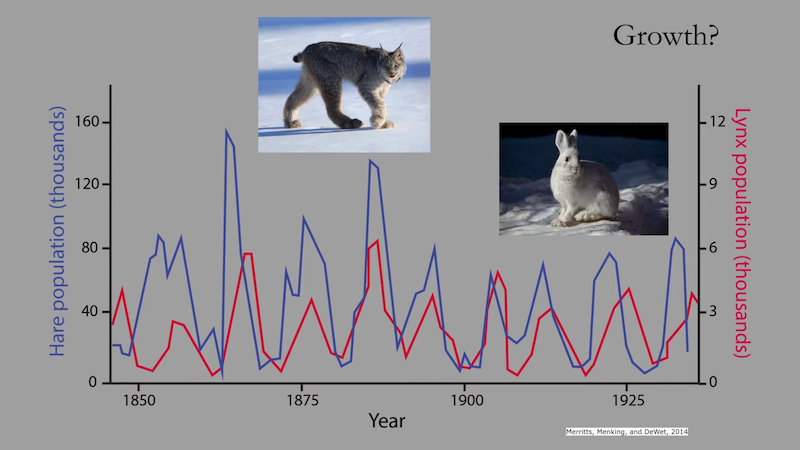
In all natural systems, you have these cyclic curves that things generally follow. We are always assuming things like our population and our economies to always go up, but that is not the way the world works; it has never been that way, and we always have these kinds of corrections. In this case, a predator follows the prey. Once its prey runs out, then the predators start dying off.
How do we get good at failing, but not totally dying out? The lynx never dies out totally, but companies that do one thing are bad at recovering when that one thing is no longer the big commodity. It wasn’t record companies that invented iTunes; it was an outsider company. Record companies were adept at selling plastic circles and when there were no plastic circles to sell music on, they didn’t know how to adjust for that. The crux of anything that’s going to last for a long time is: how do you get good at reinvention and retooling?
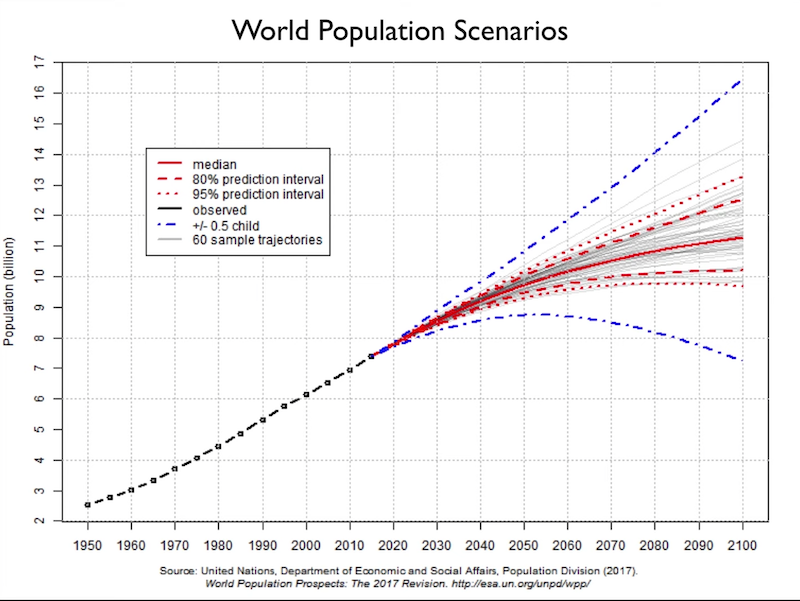
There’s no scenario that I’ve seen where the world population doesn’t start going down by at least a hundred years from now, if not less than 50 years from now.
So even the median projection, that red line in the middle, tapers off. But this data is a couple of years old, and it’s now starting to increasingly look a lot more like that dotted blue line at the bottom. And the world has really never lived through a time, except for a few short plague seasons, where the world population was going down — and, by extension, where the customer base was going down.
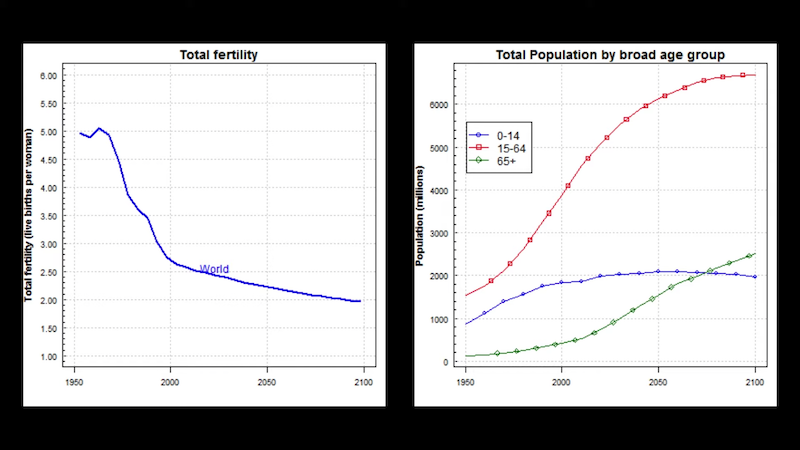
Even more dangerous than the population going down is that the population is changing. The red line here is the number of 15 to 64 year olds. And the blue line is the zero to 14 year olds. If the world is made up largely of older people who hoard wealth, don’t work hard, and don’t make huge contributions of creativity to the world the way 20 year olds do, that world is a world that I don’t think we’re prepared to live in right now.
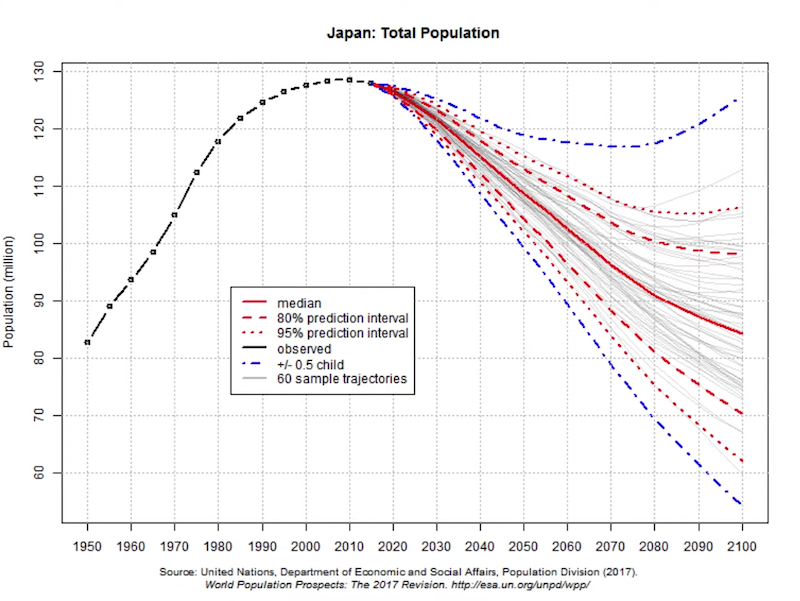
We’re seeing this now happening in a lot of the developed world and most notably in Japan. Those of you who remember the 01980s recall that there was no scenario where Japan was not an absolute dominant part of the economy of the world. And now they’re struggling just to be relevant in a lot of ways, and it’s largely because this population change happened and the young people were not there. They wouldn’t allow any immigration, and that creativity, and that thrust of civilization, went out of a country that was a dominant world economic power.